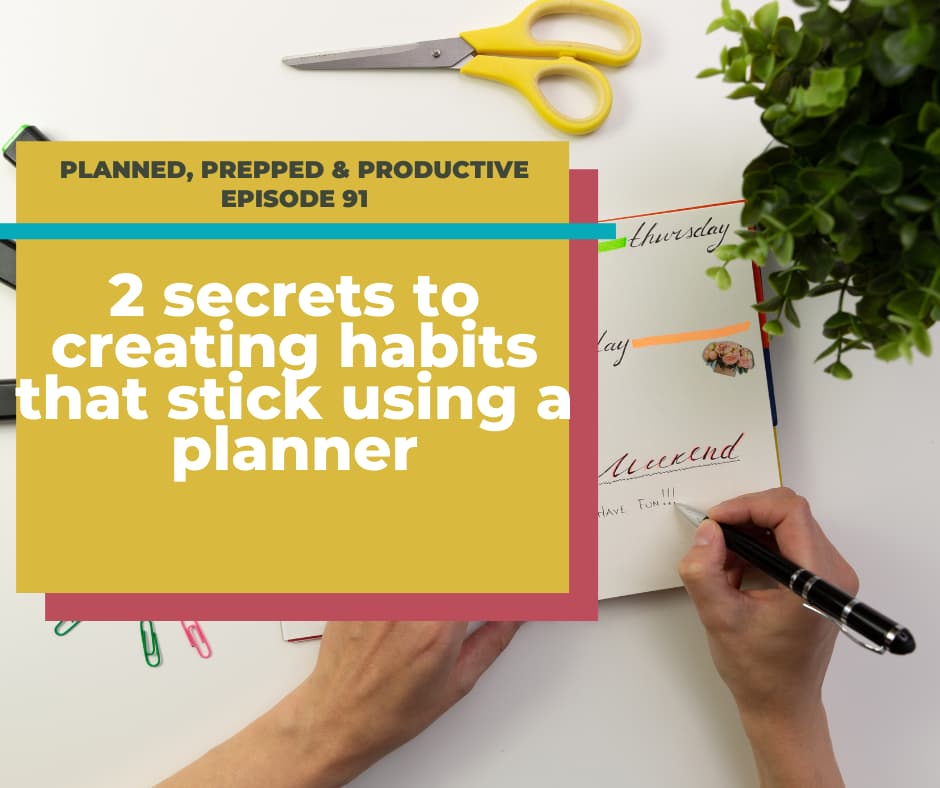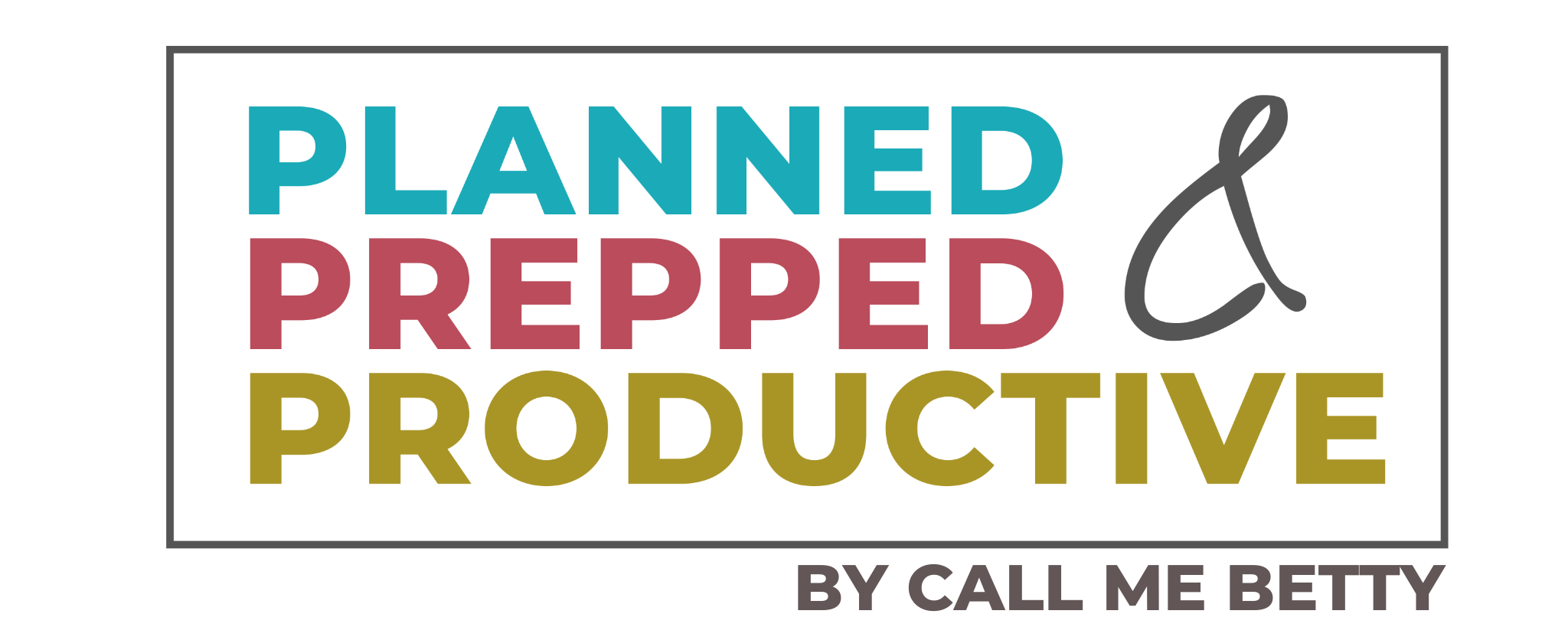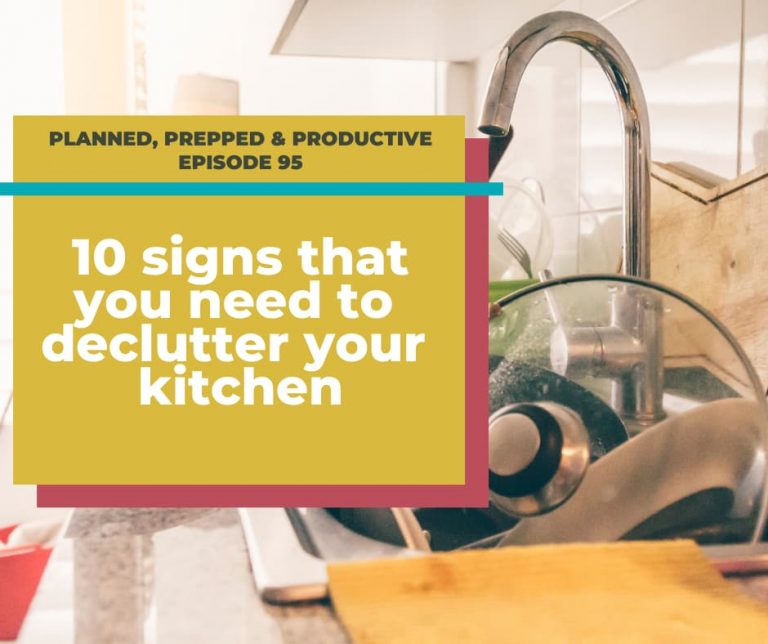Two secrets to creating habits that stick (using a planner)
Have a hard time sticking to your goals and habits? You’re probably not evaluating and reflecting enough! Learn to do just that and create habits that stick (using your planner) in today’s episode of the podcast!

Hi friends, welcome back to the podcast!

I’m excited to dive into today’s episode of the podcast which is a bit of an extension from last week, but different and extensive enough that I thought it could use it’s own episode.
So let’s talk goals for a minute.
You’ve no doubt heard about smart goals.
Goals that are Specific, Measurable, Attainable, Realistic, and Timebound.
I’ve talked about this on the podcast before and this is really just an intro to creating habits that stick, so I’m going to try to keep this brief…but let’s talk quickly about what each of these words in the SMART acronym means.
Specific means that the goal is clear not vague, measurable means the goal can be measured in some way (I find this similar to specific), attainable means that it’s in your power to achieve it, it’s not hugely outside your reach, realistic is similar, you know yourself, will you actually work to accomplish this, and timebound means you give yourself a deadline.
Now I don’t know about you, but SMART goals were the only goal-setting system that I learned in school, and it was how I usually approached goals until I found it incredibly frustrating because it just didn’t work.
Let me give you an example. A few years ago I decided I wanted to lose weight (this was before a weight loss goal was outside of my personal belief system so forgive me for the analogy here.
I am a dietitian, I know that a weight loss of 1-2 lbs a week is realistic and healthy for most individuals. I calculated my needs, figured out how many calories I would need to eat to lose that much weight per week, gave myself a little extra cushion of time to meet my goal and I was on my way.
Well, imagine my surprise that my weight loss didn’t follow the books, in fact it was completely non-existent despite eating the recommended calories for a month.
I kept at it for awhile, but every week that I didn’t lose any weight my original goal became less and less realistic. Eventually I was forced to accept that it would be impossible (or at least very unhealthy) to reach my goal and I gave up.
I found that smart goals were missing a few things. What if I wanted to make a goal that was less specific like yell at my kids less? or be kinder in general? Should I just not try because it’s not specific or measaurable? What if I want to create a habit that lasts forever like exercise daily….but I don’t want it to have to be a “goal” forever?
Another issue with smart goals for me is the lack of the most important steps of goal setting (in my opinion) evauation and reflection. Your goal should always be shiftable or changeable based on how things are going.
I like to approach goals now more like a math problem or a problem to be solved. I expect there to be roadblocks, opportunities to shift and change the goal into something different, and the chance to make real lasting changes, not just reaching a goal only to fall back into bad habits.
So I’m going to share with you my 2-step approach to goal setting using my planner that has made a huge difference!
The 2 steps are the rule of 3, and the 3 Rs. Since you have no idea what these are (ahem, because I made them up).
How to create habits that stick using the rule of 3 of planning
Okay so the rule of 3 goes like this. I only want you to be working on 3 things at a time. Let me break it down for how it works.
Starting your year I want you to choose 3 categories of goals. These can be physical health, emotional health, financial health, family life, social life, career goals, intellectual goals, mindfulness goals, spiritual goals, etc…
The categories can be whatever you want but try to choose 3 different categories. It can be difficult and overwhelming if you have too many goals in one category. So if I’m working on physical health it would be somewhat challenging to work on exercising daily, drinking enough water, and eating 5 servings of fruits and vegetables all at the same time. It’s much easier to choose on goal in the category and add new goals when you’ve established previous goals as habits that stick. The 3 categories will serve as your categories of goals for the year.
Because this is the rule of 3s you will choose 3 goals to work on for the next 3 months. One in each of the categories. If you have a measurable goal or deadline you can make a concrete goal that you will work to finish in three months. If you have a more habit-based goal you will work on and reflect on it for at least 3 months and you will decide if you need more time to work on the habit or if you’re ready to move on to something new or move deeper into the same topic (for example maybe you’ve been working on exercising daily and you feel like you’ve made that a habit, so then you decide to go deeper the next 3 months by making a goal to run at a certain speed or learn to do a pull-up (a distant goal that I have been meaning to do but still can’t).
To accomplish these three goals you are going to break it down into smaller pieces starting with the month. So what will you do the first month in each category to reach your goals. Some goals can’t really be broken down and that’s okay, but others can. I find breaking goals up especially effective for big goals, like a business goal of launching a product.
Then you can break that goal up even further. I do this by creating a weekly and daily top 3. So each week I will have a weekly top 3 which are the only 3 non-negotiable things I need to accomplish that week. I also have a daily top 3 to help me accomplish the weekly top 3.
Let me give just a few hints on making this successful.
First off, sometimes my top 3 have nothing to do with my goals, but they actually have to happen. It still helps me to accomplish my goals by getting the priorities taken care of giving me time to do other things.
The next tip for success in creating habits that stick using your planner is to avoid wasting time writing down anything that is already a habit. Remember, we are creating habits that stick. At this point, I brush my teeth every morning and night. I don’t need any sort of reminder to do it, so it would be silly to write it down. This is an extreme example to prove a point, but writing in a planner takes time and having too many things on your planner can you feel overwhelmed. So if you’re going to do it anyway, no need to write it down. Once we establish habits using this system, we’ll want to stop writing things down that are habitual and move on to new habits that we are trying to create.
Okay so that’s the rule of 3 3 major categories, 3 goals over 90 days accomplished using your weekly and daily top 3…but the thing that’s really going to make the rule of 3 work is using the 3 Rs.
Using the 3Rs to create habits that stick
The 3 Rs are Reflect, Reevaluate, Redirect
Reflect
This key step tends to be overlooked so often with goals. We need to spend time reflecting on our goals, reflecting on how things are going, reflecting on if we are making progress or not. We can reflect on our goals every single day by adding a daily reflection to our planner/journals. I recommend reflecting daily, weekly, monthly, and yearly to be sure that your goals are in line with your values and you are making the progress you want to. Which brings me to the next R which is Reevaluate.
Reevaluate
This is another step that tends to get missed. It seems like so often instead of reevaluating whether or not a goal is working, we just give up. By reevaluating we can see what problems we are coming up against over and over again and see if we need to adjust our goal in order for it to be effective. Maybe our goal was less realistic than we thought, so instead of giving up we can just spend some time evaluating what we could do differently. The last thing we will do is make a decision.
Renew or Redirect
If your goal is going relatively well and you just need to keep working, or even if you’ve been struggling but you can’t pinpoint a change and you want to keep going you may just need to renew your goal after you reevaluate. If in your reevaluation you decided things needed to be changed or shifted you can use this opportunity to redirect your goal a little bit for the next week. That might mean simplifying it a little, or getting help so you can actually accomplish it, or changing the direction of it slightly.
Repeat this as often as possible, I do the full 3 Rs once a week, but I try to do a little reflection every single day to make sure I’m aware of my goals constantly, and always working towards progress.
Overall this system of the rule of 3s and the three Rs has been the most effective thing I have tried when it comes to creating habits that stick. There are certainly loads of other helpful tips and tricks, but this system is my foundation. I hope you have learned something that you can try and that you feel more confident making goals moving forward!
Next week on the podcast we’ll have an awesome guest who will be teaching us all about creating healthier family meals! I’m excited for you to meet her!
Thanks for listening friends, until next time, happy planning!
Need a planner to get started? Here’s a basic one that will work well for your needs!
If you missed last week’s episode on planners it’s a great precursor to this one! If you want to learn more about habits check out this episode!






